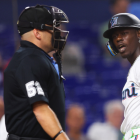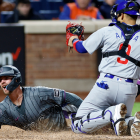
The NCAA Division I Baseball Tournament field of 64 has been announced and seeded, and regional action gets underway starting Friday. It all leads up to the eight-team Men's College World Series in Omaha that begins on June 16.
As such, it's high time we preview the 2023 edition of the tournament, and we'll do that now via the time-honored FAQ format. Let us begin.
1. So how does all this work?
Given that college baseball isn't as widely followed as the football and basketball collegiate variants, perhaps a brief postseason explainer is in order. Here's how it all works, in bullet-point format for today's harried sales professional ...
- The first round of play is known as the regional, and it's a double-elimination format featuring four teams. Each of the 16 one-seeds hosts its respective regional, when possible. Only one team out of four survives each regional.
- The winner of each regional advances to the 16-team super regionals, which is a best-of-three series between two regional winners.
- The winner of each super regional -- eight teams in all -- advances to the College World Series in Omaha.
- The College World Series is a double-elimination format until the final two teams are left standing. At that point, the slates are wiped clean, and it's a best-of-three series to determine the national champion.
It's definitely not what you're accustomed to if you come to this as a consumer of March Madness, but the baseball version typically provides similar levels of drama and intrigue.
2. Who are the favorites?
The field of 64 also includes eight national national seeds, which you may consider the pre-tourney favorites to reach Omaha. National seeds get to host super regionals should they advance that far. As for this year's crop of national seeds, here they are in order:
- Wake Forest
- Florida
- Arkansas
- Clemson
- LSU
- Vanderbilt
- Virginia
- Stanford
Obviously, all of those won't wind up in Omaha, but these eight teams have the strongest pre-tournament resumes and should be expected to make deep runs. On the historical front, No. 5 seed LSU is tied with Texas with six national championships – second only to Southern Cal's 12. As for pre-tourney top dog Wake Forest, their lone College World Series title came back in 1955. Of the eight national seeds, just two teams – No. 3 Arkansas and No. 4 Clemson – have never won it all before. Arkansas has finished CWS runner-up on two occasions.
3. Does the SEC still lord over all?
It certainly appears this way. The SEC snared 10 bids overall – the most of any conference (the ACC is second with eight bids) – and a record eight of those 10 teams will host their regionals. SEC teams have also won three straight national championships and four of the last five. As well, the SEC is coming off a 2022 season in which it placed four teams in the Men's College World Series. So until further notice, yes, the SEC is the strongest conference in college baseball.
4. Will there be a repeat on the table?
Nope. Last year's national champion Ole Miss failed to make the field of 64 despite high preseason expectations. The Rebels finished 25-29 overall and just 6-24 in SEC play, and that wasn't enough to snare an at-large bid. That means the last team to win back-to-back Men's College World Series will remain South Carolina in 2010 and 2011.
However, it is possible that the state of Mississippi will claim a third straight title, which is something that hasn't happened since Southern Cal won five in a row from 1970-74. As noted, Ole Miss won it all in 2022, and Mississippi State claimed the belt and title in 2021. Neither made it to this year's tournament, but Southern Mississippi did. Therein lie the hopes for the Magnolia State.
5. Who's the cinderella?
This year it's without question Tulane. The Green Wave were the upset winners of the American Athletic Conference tournament, which allowed them to sneak in as one of the 31 automatic qualifiers. The kicker is that the Green Wave finished the season with a 19-40 overall record and an 8-16 mark in conference play. All of that gave them a ranking of just 158th in the RPI.
They'll be playing in the Baton Rouge regional, and as a fourth seed they're tasked with playing in-state rival LSU, the consensus No. 1 team coming into the season, in the opener. Not since Stony Brook in 2012 has a No. 4 seed made it to the Men's College World Series.
6. Who are some players to watch?
Our draft/prospect maven R.J. Anderson will soon have a deeper dive into which players in this year's tournament have the potential to be impact contributors at the highest level. In advance of that, however, we'll give you a handful of names to watch.
Most notably, there's LSU center fielder Dylan Crews. Simply put, Crews, who will likely be the top overall pick of this year's draft, has the highest ceiling among draft-eligibles in quite some time. That's mostly because of his elite skills at the plate. Thanks to his best-in-class power and hit tools, he's going to be a quick mover once he makes the leap to the pros. This season, Crews for the Tigers batted a stratospheric .420/.567/.710 with 15 home runs in 58 games and 58 walks against 38 strikeouts. In SEC play, Crews slashed .405/.545/.685 with eight home runs in 29 games.
Some other names to know:
- LSU right-hander Paul Skenes is the best arm available according to some boards, and there's a shot that Crews and his teammate go 1-2 in the draft.
- Florida left field Wyatt Langford boasts excellent plate discipline, and this season he's cracked 42 extra-base hits in 51 games. He's likely a top-10 pick.
- Vanderbilt center fielder Enrique Bradfield Jr. is another player in this tournament who could go in the top 10 of the draft. He profiles as a leadoff type, what with his speed on bases and willingness to work counts and take walks.
- Tennessee righty Chase Dollander has good fastball velocity and not one but two wipeout breaking balls.
- As for No. 1 overall seed Wake Forest, right-hander Rhett Lowder is the one to watch. He boasts three pitches that profile as major-league quality and strong groundball tendencies.
This of course isn't an exhaustive rundown, but it's a taste of what's out there in fairly strong collegiate draft class.
Now let the Road to Omaha begin in earnest.






















